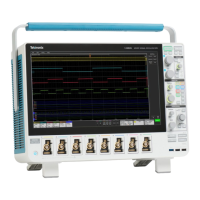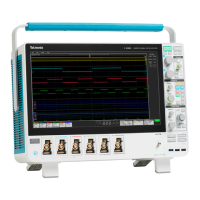Commands listed in alphabetical order
Arguments
<NR1> =0turnso
ff average mode, and any other integer turns on average mode.
OFF turns off average mode.
ON turns on average mode.
Examples
MATH:MATH2:AVG:MODE ON sets the average mode on.
MATH:MATH1:AVG:MODE? might return :MATH:MATH1:AVG:MODE 0,
indicating average mode is off.
MATH:MATH<x>:AVG:WEIGht
This command sets or queries the number of acquisitions a t which the averaging
algorithm will begin exponential averaging. The math waveform is specified by x.
Group
Math
Syntax
MATH:MATH<x>:AVG:WEIGht <NR1>
Related Commands
MATH:MATH<x>:AVG:MODE
Arguments
<NR1> is the number of acquisitions at which the averaging algorithm will begin
exponential averaging.
Examples
MATH:MATH2:AVG:WEIGHT 143 sets the number of acquisitions needed
to begin averaging to 20
MATH:MATH3:AVG:WEIGHT? might return
:MATH:MATH3:AVG:WEIGHT 20 indicating the number of acquisitions needed
to begin a veraging is 8.
MATH:MAT H<x>:DEFine
Thiscommandallowsyoutodefine new waveforms using mathematical
expressions. The query form of this command returns the math definition for the
specified math waveform. The math waveform is specified by x.
You can specify a math expression from waveforms, m easurements and scalar
sources, functions, operands, a nd numerical constants.
Math expressions can be simple, such as Ch1, which specifies that a waveform
should show the signal s ource of Channel 1 with no mathematical computation.
Math expressions can also be complex, consisting of 100 plus cha racters and
comprising many sources (including other math waveforms), functions, and
operands. As an example, you can enter the expression Log(Ch1+Ch2), which
MSO54, MSO56, MSO58, MSO58LP Programmer 2-365
